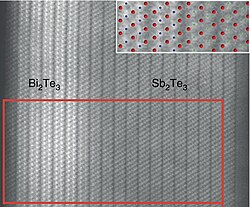 Electron micrograph of a seamless Bi2Te3/Sb2Te3 heterojunction and its atomic model (blue: Bi, green: Sb, red: Te) [1] | |
| Names | |
|---|---|
| Other names antimony telluride, antimony(III) telluride, antimony telluride, diantimony tritelluride | |
| Identifiers | |
3D model (JSmol) | |
| ChemSpider | |
| ECHA InfoCard | 100.014.074 |
PubChem CID | |
| |
| |
| Properties | |
| Sb2Te3 | |
| Molar mass | 626.32 g·mol−1 |
| Appearance | grey solid |
| Density | 6.50 g cm−3 [2] [3] |
| Melting point | 620 °C (1,148 °F; 893 K) [2] |
| Band gap | 0.21 eV [4] |
| Thermal conductivity | 1.65 W/(m·K) (308 K) [5] |
| Structure | |
| Rhombohedral, hR15 | |
| R3m, No. 166 [6] | |
a = 0.4262 nm, c = 3.0435 nm | |
Formula units (Z) | 3 |
| Hazards | |
| NIOSH (US health exposure limits): | |
PEL (Permissible) | TWA 0.5 mg/m3 (as Sb) [7] |
REL (Recommended) | TWA 0.5 mg/m3 (as Sb) [7] |
| Related compounds | |
Other anions | Sb2O3 Sb2S3 Sb2Se3 |
Other cations | As2Te3 Bi2Te3 |
Except where otherwise noted, data are given for materials in their standard state (at 25 °C [77 °F], 100 kPa). | |
Antimony telluride is an inorganic compound with the chemical formula Sb2Te3. As is true of other pnictogen chalcogenide layered materials, it is a grey crystalline solid with layered structure. Layers consist of two atomic sheets of antimony and three atomic sheets of tellurium and are held together by weak van der Waals forces. Sb2Te3 is a narrow-gap semiconductor with a band gap 0.21 eV; it is also a topological insulator, and thus exhibits thickness-dependent physical properties. [1]